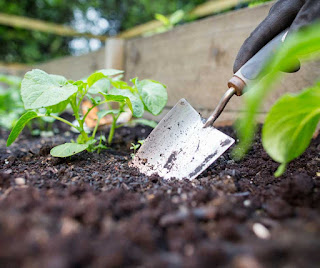Humus (Latin humus: earth, ground) is the dark organic matter that forms in soil when dead plant and animal matter decays. Humus has many nutrients that improve the health of soil, nitrogen being the most important.
The ratio of carbon to nitrogen
(C: N) of humus is 10:1.
It is a natural body having variable heterogeneous mass. Although the terms "organic matter" and "humus" are often used interchangeably, they are different.
Humus is a small, stable portion of the total organic matter in soil.
The process by which dead material and modified
organic matter forms the more complex and stable humus is known as humification. The formation of humus is
strictly a biochemical process.
In the earth sciences, "humus" means any organic matter which has reached a point of stability, where it will break down no further.
In agriculture,
"humus" means mature compost, or natural compost extracted from a
forest or other spontaneous source for use to amend soil.
Soil
Humus is also known as “Soil skin/Flesh”.
Soil humus is produced upon decomposition of organic matter mainly by microbial synthesis of biological products.
Humus has a characteristic black
or dark brown colour and is organic due to an accumulation of organic carbon.
Humus can be divided into
different humic substances
- Ø fulvic
acids, which are soluble in water of any acidity;
- Ø humic
acids, which are darker in color and soluble in all but the most acidic
conditions;
- Ø humin,
the insoluble portion of humus
Humus
formation -
Humification of organic
residues depends upon their chemical composition and
soil conditions influencing the activity of soil micro-organisms.
Humus formation from the residues of plant
and animal is two- stage process:-
1. The decomposition of the tissue components and their conversion by micro-organisms into simpler chemical compounds and partially to products of complete mineralization (CO, NO, NH, CH, H, O etc.).
2. The synthesis of
organic compounds with the formation of high molecular weight humus substances.
Decomposition
by Micro organisms
Microorganisms decompose a large portion of the soil organic matter into inorganic minerals that the roots of plants can absorb as nutrients. This process is termed "mineralization".
In this process, nitrogen (nitrogen cycle) and the other nutrients (nutrient cycle) in the decomposed organic matter are recycled. Depending on the conditions in which the decomposition occurs, a fraction of the organic matter does not mineralize, and instead is transformed by a process called "humification" into masses of organic polymers. Because these organic polymers are resistant to the action of microorganisms, they are stable, and constitute humus.
Humus integrates into the permanent structure of the soil, thereby
improving it.
Organic matter is humified by a combination of saprotrophic fungi, bacteria, microbes and animals such as earthworms, nematodes, protozoa, and arthropods.
Plant remains,
including those that of animals digested and excreted, contain organic compounds:
sugars, starches, proteins, carbohydrates, lignins, waxes, resins, and organic
acids. Decay in the soil begins with the decomposition of sugars and starches
from carbohydrates, which decompose easily as detritivores initially invade the
dead plant organs, while the remaining cellulose and lignin decompose more
slowly. Simple proteins, organic acids, starches, and sugars decompose rapidly,
while crude proteins, fats, waxes, and resins remain relatively unchanged for
longer periods of time. Lignin, which is quickly transformed by white-rot
fungi, is one of the primary precursors of humus, together with by-products of
microbial and animal activity.
During humification, microbes secrete sticky, gum-like mucilages; these contribute to the crumby structure (tilth) of the soil by adhering particles together and allowing greater aeration of the soil.
Much of the humus in most soils has persisted for more than 100 years,
rather than having been decomposed into CO2, and can be regarded as
stable; this organic matter has been protected from decomposition by microbial
or enzyme action because it is hidden inside small aggregates of
soil particles, or tightly complexed to clays. Most humus that is not
protected in this way is decomposed within 10 years and can be regarded as less
stable or more labile.
Stable humus contributes
few plant-available nutrients in soil, but it helps maintain its physical
structure.
Properties of humus
- Ø Humus
is highly colloidal and highly adsorptive (more than clay)
- Ø Humus
is hydrophilic and improves the water-holding capacity of soils. (From a
saturated atmosphere humus absorb 80-90% water while clay absorbs only 15-20%)
- Ø Humus has a very favorable effect on aggregate formation and stability.
- Ø The
biochemical structure of humus enables it to moderate, i.e. buffer, excessive
acidic or alkaline soil conditions.
- Ø Humus
colloids protect microbes and plants from excessive damaging sodium, magnesium
and potassium, minerals that are positively charged and attracted to the negative
charge of the humus colloid.
- Ø Humus can form complexes with metal ions and compounds, including toxic pollutants. This property can reduce toxicity or capture pollutants
- Humus impart black colour to soils
- Benefits of humus
There are many benefits
of humus compost to the soil.
• Disease suppression —
humus compost has a healing effect on plants and a cleansing action on
soils.
• Increases plant yield
• Porosity increased in
the soil-has more air voids than typical soils.
• Nutrient retention —
magnetic charge from high CEC holds nutrients longer.
• Compaction reduction —
it makes soil spongy and enables it to spring back.
• Helps reduce dependence
on chemicals — promotes healthier plants.
• Erosion
reduced-disperses the force of raindrops.
• Water retention
increased — like a sponge holding water.
To
maintain or increase the level of humus in soil, it is important to ensure a
steady, adequate, supply of crop residue and organic matter. Use low or no-till
practices, and responsibly fertilize crops to increase plant mass, and grow
cover crops.





No comments:
Post a Comment